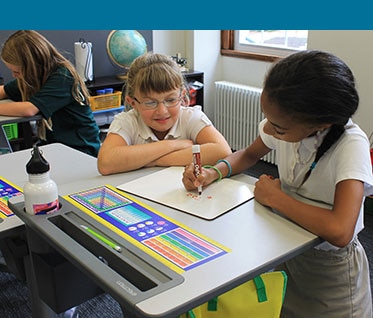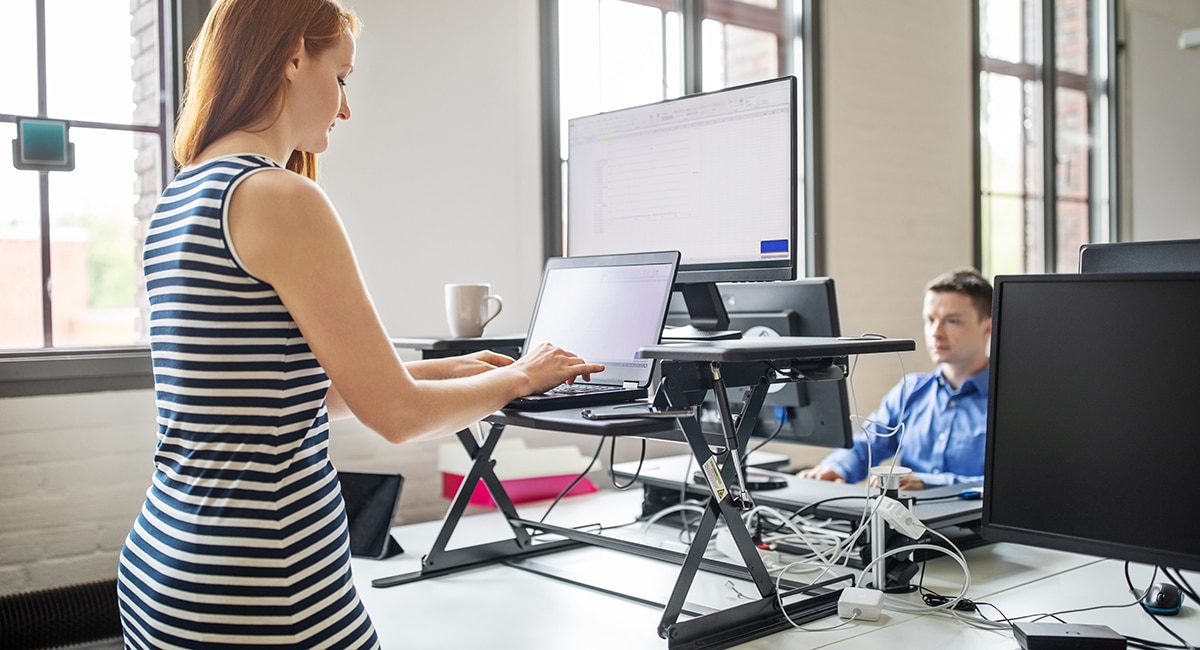How Furniture Influences Learning
Schools use mobile classroom designs to get students
to actively tune in to lessons.
by | Jacquelyn Bengfort
Jacquelyn Bengfort is a freelance writer based in Washington, DC. A social anthropologist by training, she writes on topics from education to the military, gender to fictional post-apocalyptic worldscapes.
The world has changed, but education is notoriously slow to adapt.
“Education, in general, is one of the most resistant and stubborn-to-change entities in the world,” says Mike Patterson, a K–12 education strategist at CDW•G. He speaks from experience; before joining the company, Patterson spent a decade as a teacher and school administrator.
He’s seen the resistance that new technology often faces upon introduction to a school setting — and he’s seen how teachers who sign on to a pilot may struggle to break old habits or to find the best way to incorporate the tech into their teaching.
The result is students who aren’t ready for the future.
“K–12 has not necessarily been preparing students for the workforce,” Patterson says, noting that students who are deskbound in traditional classrooms aren’t practicing the collaborative, mobile methods of modern workplaces.
The National Education Association has identified “the four C’s” — critical thinking, communication, collaboration and creativity — that are crucial for success in the 21st century. These skills, more so than narrow preparations in the form of specific certifications or training on platforms, are the ones that will make students adaptable for a future that is still being written.
Here’s another problem: If students remain stuck in rows of desks, mobile technology in that isolated atmosphere can actually exacerbate a lack of communication and collaboration in a classroom.
But there’s a solution that helps sidestep the potential isolating effects of mobile technology: the standing desk.
15
The additional calories a student will burn per hour standing versus sitting, according to Mayo Clinic estimates
Source: JustStand.Org, “Making the Grade: Why Classroom Movement Gets an A+”
Standing Up for Students
As research began to reveal the dangers of excessive sitting — one doctor coined the phrase “Sitting is the New Smoking” to describe the detrimental effects — the business world embraced standing and variable-height desks, such as the Ergotron WorkFit line. But these desks needed to be reimagined before they could spread to schools.
Unlike the WorkFit sit-stand desks, the LearnFit series needed to stand up to hard use by multiple students over multiple years, says John Erickson, a senior production manager at Ergotron. And, unlike office furniture that mostly remains stationary, the LearnFit desk needed to move.
After piloting the initial design, Ergotron solicited feedback from educators across the country. The final product included a caster system and easy height adjustment, the keys to supporting an active, collaborative learning environment.
The LearnFit desks cost more than a standard sit-down desk, Erickson says, but Ergotron packed the design with additional features to ensure that it met the needs of students and teachers. There’s a water-bottle holder, a pencil tray, a backpack hook and, optionally, a cubby for extra storage. The goal is to make sure everything a student needs is there at the desk, cutting down on disruptions during the day and maximizing instructional time. For the sit-stand LearnFit desk, the height adjustment range is designed for students ages 12 through adult — an important feature given that these are the students who usually spend upward of seven hours of their school day at a desk. For younger students ages 6 and up, Ergotron offers an adjustable standing-only version.
The feedback from schools has been overwhelmingly positive. Erickson recently visited a fourth-grade classroom; students and teachers there told him that if they had the option only to sit or to stand, they would choose to stand.
“We think that’s a strong message that they really like the standing solution,” he says.
Patterson sees in mobile furniture a way to tackle three of the four C’s: collaboration, communication and creativity. Students given mobile devices in a traditional classroom setting may get trapped in a pattern of focusing on their screens instead of interacting with each other.
Collaborating and communication are enhanced when students can easily move to face each other.
“Communication and communication skills are huge,” says Patterson. “Because technology has taken such a stranglehold on how we talk and interact with each other, these types of things are going to afford opportunities for students to communicate more openly and comfortably.”
But he sees specific opportunity in the realm of creativity.
“The students will have the option of connecting with people in other parts of the room. As obvious as it sounds, if you think about a traditional classroom, students can be siloed — basically sitting around the same three or four people for a majority of the semester,” says Patterson.
“If you’re giving your kids the ability to interact with other people within the classroom, you’re allowing them to inspire each other in a variety of ways,” he adds.
Learn about how CDW•G can help your students get their feet and brains moving.

From the Classroom to the Future
“People think physical space is an innocent bystander,” says Larry Kearns, a principal of Wheeler Kearns Architects in Chicago. “But physical space will reinforce a teacher’s mission, or frustrate it.”
Kearns designs spaces that accommodate larger groups of students and teams of teachers that allow for a high degree of personalization — quite different from the “egg crate model” most people associate with K–12.
“In the schools that we’ve done that have focused on personalization, both have abandoned that model, because it is impossible to have a single instructor differentiate successfully for a large classroom,” says Kearns.
For example, in one class period, six levels of math might be taught in one room. “That, of course, is inconceivable if you had a single teacher in a cellular classroom,” he says, noting that the current trend toward mobile furnishing is the bellwether of a larger movement that will remake the way schools are built in the next half-century.
Unlikely Inspiration, Healthy Outcomes
Patterson hears one word over and over again when he speaks to school administrators: Starbucks.
The coffee chain has in many ways become ubiquitous with 21st-century styles of work. Patterson recently worked with a school district of 69,000 students in Texas; administrators specifically cited the brand when describing the warm, inviting, option-rich atmosphere they hoped to recreate in their new classrooms.
“It has become the default model, because it has flipped our definition of a place where we can be comfortable and productive,” he says, adding that schools that want to transform their spaces and equip students for the future could do worse than look at places where people love to go to work. If students have the option to move and stand throughout the day, it’s not just engaging — it’s also healthy.
According to a meta-analysis of studies involving students and standing desks published in the January 2016 issue of Pediatrics, introducing sit-to-stand desks into classrooms cut around an hour’s worth of sitting out of a student’s day. The researchers also noticed that students who stand more throughout the day burned more calories; this increase was particularly marked in children diagnosed as obese.
Making a Change That Sticks
The schools that successfully transform their learning environments do so by involving a broader range of stakeholders in the discussion, not just the facilities manager and the business office, but also the students and teachers whose day-to-day lives will be changed.
At Beaver Acres Elementary School in Beaverton, Ore., introducing standing desks was an easy sell, according to Ryan Hoxie, the Beaverton School District’s Future Ready Strategist. Instructors were already dedicated to re-imagining classrooms, but they had other considerations in mind as well.
“With all of the information now about the dangers of sitting all day long, a lot of our staff, and even some of our older students, were really dialed into the health aspect,” he says. And, says Patterson, just as with a mobile device rollout, he recommends that furniture be piloted in limited classrooms before the final schoolwide strategy is decided upon.
Successful transformations also are holistic. Administrators sometimes expect that changing the furniture, when compared to technology-intensive projects like a one-to-one device deployment, is inherently simple. But, in the absence of larger discussions and deliberate changes to pedagogy, the old model of what a classroom looks like can be imitated with the new furniture, and the hoped-for transformation unrealized.
“Schools in general need to define their learning outcomes, their goals, their visions for their district — the ‘why’ behind everything they’re doing — and not just have it be because everyone else is doing it. It has to be centered around the children,” Patterson says.
When that “why” is well-defined, the fun can begin: The market is exploding with possibilities. Standing and sit-stand desks are only two options; schools are experimenting with everything from bean bag and milk-crate seating to active stools and halls lined with counter-height tables instead of banks of lockers.
“It’s really about matching up your dream classroom with the possibilities,” Hoxie says.
1/3
The fraction of high school students getting the recommended levels of physical activity
Source: Let’s Move, Learn the Facts
Close-up on a Rollout
When Beaver Acres Elementary School in Beaverton, Ore., committed to becoming future ready, Ryan Hoxie was hired to coordinate the changes.
Initially, a big part of his role was getting devices to students and coaching teachers in the use of technology.
Then, a chance meeting with an Ergotron representative led the school to pilot 40 LearnFit desks. Hoxie and two students put them together in about three hours and dispatched them around the school.
“Part of our commitment to becoming future ready is to help reimagine what our classrooms are going to look like,” says Hoxie, “and these fit perfectly in that.”
With one or two LearnFit desks available in classrooms around the school, students have the option to stand if it will help them focus or to get a break from sitting too long. But the changes go deeper than just giving students choices.
“The furniture helps lead to decentralized learning, where it’s no longer the teacher at the front lecturing,” Hoxie says. Instead, the teacher becomes a facilitator, moving around a classroom to help individuals and groups.
Hoxie says that the future-ready initiative, now a year old, is already improving student achievement. Teachers note that their students are more focused and are taking control of their own learning. Student writing has measurably improved as well.
“That’s really what it’s all about,” Hoxie says.

Featured Partner

Call us at 800.800.4239 to set up a consultation with a mobile expert.
MKT17295

